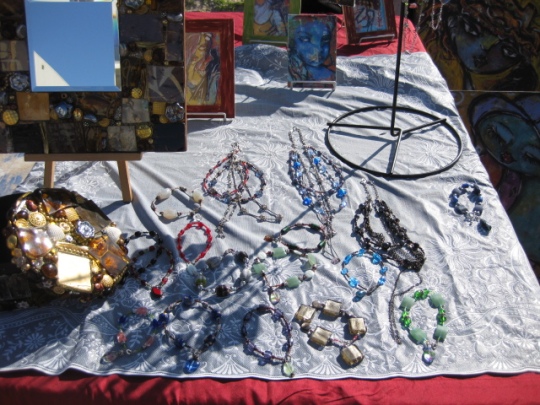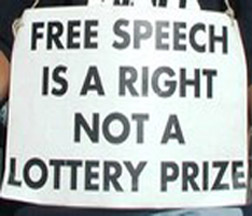Ordinance Limits What Types of Works Can Be Sold; No Pottery, Snow Globes OK
By HANNAH KARP
LOS ANGELES California
Sgt. Daniel Gonzalez has broken up bar fights, chased
armed gangbangers and even apprehended a blood-soaked murderer after a
car chase.
But nothing in his 22 years with the Los Angeles Police Department
could have prepared him for his latest responsibility: art critic.
Since January, the clean-cut cop has patrolled the beachside
neighborhood of Venice’s famous boardwalk, passing judgment on painted
porcelain skulls, henna tattoos and scrap-metal Star Wars sculptures
offered for sale. On a recent Thursday, he told a dread-locked artist
dabbling in a variety of media that he should “get more into the wood
stuff, less into the hats.”
“Now this is what people are looking for,” Sgt. Gonzalez told another
artist, offering what he called “positive reinforcement” for selling
on-the-spot spray paintings. “Do you really take Visa? That is
awesome.”
Sgt. Gonzalez inspects wares on the boardwalk in Venice Beach.
Sgt. Gonzalez’s new duties are part of one of the LAPD’s more unusual
mandates: keeping Venice weird.
Famous for its funky mix of performers, skateboarders and runaways,
Venice Beach is one of California’s biggest tourist draws in part
because day-trippers are all but guaranteed to see something strange.
But increasingly the surfside community is battling to preserve its
character as big businesses and wealthy individuals move in,
threatening the very quirkiness that helped attract them in the first
place.
Google Inc. recently opened a Southern California office in Venice.
Hollywood producer Joel Silver is converting Venice’s old post office
into his corporate headquarters. And a Canadian company recently won
approval to install a controversial zip-line ride along the boardwalk,
infuriating locals who fear it will only exacerbate the area’s traffic
and commercialization.
The L.A. City Council last December passed a new ordinance that
effectively banned anyone but local artists from engaging in
commercial activity on the boardwalk’s beach-facing side. Ordinance
violators are subject to fines and repeat offenders can end up in
jail.
That has left it to officers like Sgt. Gonzalez to routinely weigh in
on a debate more suited to the Museum of Modern Art or the Guggenheim:
What constitutes art?
Residents say making the cops police art isn’t ideal, but there is
little alternative.
“You could have volunteer boardwalk walkers, but then what?” says Matt
Kline, director of outreach for the Venice Neighborhood Council. “It
is a tough job for the police to do, but this is an ordinance, so
they’re really the only people who can do it.”
Venice, a former epicenter of Beatnik culture that now attracts 16
million visitors a year, according to the Venice Chamber of Commerce,
has long struggled with how to regulate the freedom of expression on
the wide, concrete path that borders the beach, officially known as
“Ocean Front Walk.”
There were virtually no rules governing commerce on the boardwalk
until two decades ago, when the city banned unlicensed vending there
at the behest of local merchants who complained that vendors were
stealing their business.
But in 1997 a federal appeals court overturned the ban, arguing it
trampled First Amendment rights. Since then the city has tried
implementing a slew of different rules to avoid sheer chaos—for
example requiring artists to enter a lottery for “Public Expression
Participant Permits.” But each version of the law proved either too
restrictive or too vague to hold up in court, deterring some police
from issuing citations altogether.
Now, though, Sgt. Gonzalez says he thinks the city has finally hit the
nail on the head. The ordinance that took effect earlier this year
gives police more explicit guidelines than ever to determine what
qualifies as art. Pottery doesn’t count as art because it has a
utility apart from its artistic message, according to the ordinance,
nor do any goods that appear mass produced, like home appliances and
auto parts.
Still, he says there is plenty of gray area. Hula-hooping might be
performance art, but selling hula hoops is not. Hand-drawn henna
tattoos can pass for art, but those made with mass-produced stenciled
designs are another story. Mass production is difficult to determine,
too, since the ordinance gives no specific number of items that
constitutes a “mass.”
Sgt. Gonzalez says he is no art aficionado—he studied business and
economics in college, and the 45-year-old Southern California native
says most of his art education came from working for several years as
a part-time security guard for Sotheby’s in Beverly Hills, shortly
after he joined the police force in 1990.
While working at the art auction house during his off-duty hours, he
says he “saw a lot of cool stuff” and developed a particular
appreciation for Impressionist artists like Paul Cezanne.
“I don’t know how they came up with that oil-based paint—how thick and
real it looks,” says Sgt. Gonzalez.
J. Scott Smith, a homeless man, sells cardboard “bum signs” that qualify as art.
Still, he isn’t afraid to give pointers to the boardwalk artists about
what he thinks will sell—and spends much of his time encouraging
ordinance violators to find their hidden talents. This year he says he
inspired one crystal vendor to make beach-themed snow globes from her
precious stones, since selling plain crystals is a no-no, and he says
he spurred another woman to melt crayons onto canvases with a
blowtorch.
This spring, J. Scott Smith, a homeless man who has lived in Venice
for several years, says he asked Sgt. Gonzalez: “What do I have to do
to stay here?”
“I said, ‘Create something, perform,’ ” Sgt. Gonzalez recalls. “If
you’re out here and you do have some creative juices flowing inside
you, figure it out.”
Now, Mr. Smith makes and sells cardboard “bum signs” with messages
like “Need $ To Bail Mom Out of Jail” and “Couldn’t think of Anything
Snappy So Just Give Me a Dollar And Beat It.”
Art policing isn’t for everyone: Sgt. Gonzalez says that since he
joined the beach patrol in January he has seen three officers quit the
patrol. But he has no plans to leave. “It’s a little bit of higher
calling,” he says.
————————————
 From Venice Beachhead:
From Venice Beachhead:

Recent Comments